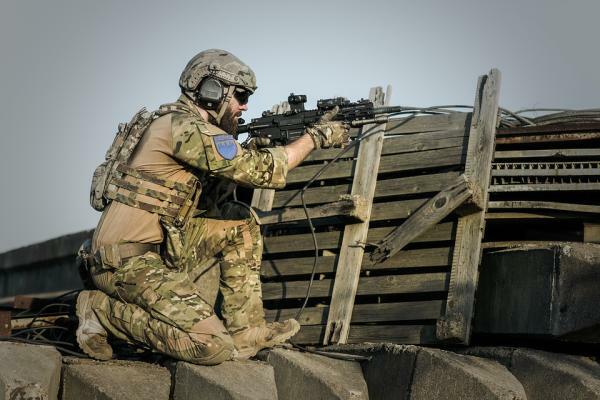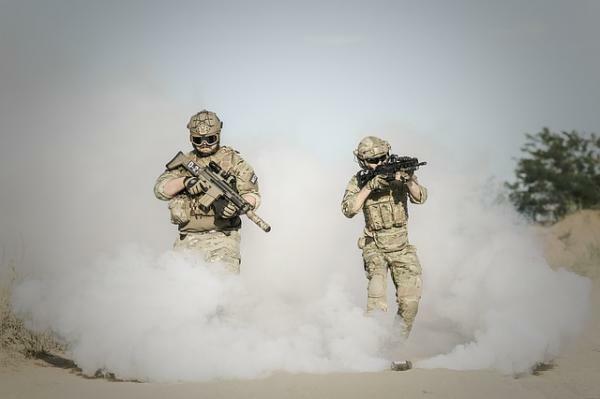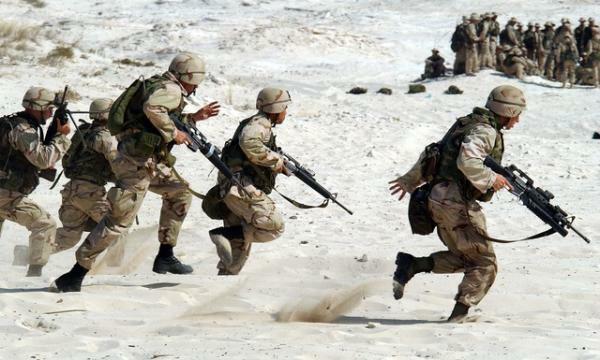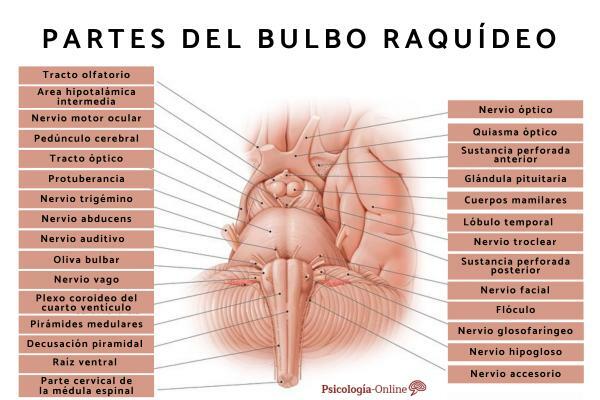
In a warlike confrontation between two forces, both share a goal: to undermine the opponent, breaking their readiness to fight. The way to achieve this is usually by inflicting the most difficult conditions on the adversary, so that he resists for the shortest possible time and stresses arise among his members. In this Online Psychology article we are going to discover you what is Combat Stress Reaction talking about its causes and the treatment that can be carried out to overcome this condition.
Index
- Introduction to Combat Stress Reaction (REC)
- Implications of the definition of REC
- Primary Causes of Combat Stress Reaction
- Secondary causes of REC
- The importance of physical and physiological factors
- How to deal with the Combat Stress Reaction
- The importance of RECs in combat
Introduction to Combat Stress Reaction (REC)
The leadership collapse and unit cohesion they suppose the beginning of the fall of one of the two sides. When the leader is no longer perceived as capable of leading to victory and survival, and if esprit de corps is broken, the battle seems lost. Under such conditions, l
In WWII combat divisions the percentage of REC with psychiatric appearance was 28% of the force (Brill et als, 1953). In infantry battalions, in advance, it exceeded 33%. Around 1942, psychiatric evacuations outnumbered the contingent that the United States could mobilize (Glass et als., 1961). Certain combat divisions, for every 1,600 annual casualties, had 1,000 evacuations psychiatric (Beebe et als, 1952), coming to suppose on specific days up to half of the daily bowel movements.
When evaluating and weighing these data, given their volume, it is necessary to consider what their true magnitude is. Regarding the total casualties, the RECs accounted for between 10% and 40% in battle for the American army, throughout World War II. But in the Pacific, throughout the war, a psychiatric REC was counted for every wounded person (Glass, op. cit.). In Israel, in the Yon Kippur War of 1973, in certain units, REC casualties accounted for up to 70% of the wounded (Levav et als., 1979).
However, it should be noted that such data have been obtained using a narrow definition of REC. That is, without considering such a reaction in combatants with other types of injuries. These could contribute to increasing REC figures by 30% (Noy et als., 1986). Thus, in Israeli battalions deployed in the 1982 Lebanon War, for each wounded, 1'2 REC were given. Such data indicate that RECs, far from being a fixed number, are a fluctuating value, depending on the severity and hardness of the combat that the troops have experienced and their evaluation.

Implications of the definition of REC.
Definitions of REC have evolved over time. This has been done according to three levels of inclusion, from the most restricted to the most comprehensive. Placing ourselves in the strictest pole, only those subjects diagnosed as such on the battlefield are considered casualties by REC when they present an established clinical picture.
A broad definition, however, considers low RECs to all the subjects identified for evacuation and exhibiting some psychiatric symptom on the battlefield. A third definition of set, considers as REC any injured subject evacuated for any reason different from being hit by enemy fire, when it presents somatic and behavioral manifestations of stress.
Although it may seem like a trivial topic, it is not so much, especially if we stick to the data. In the Vietnam War, using the narrow definition, low REC rates were given, and at the same time a number of significant number of evacuations derived from drug use, psychosis and disciplinary problems due to the significant stress suffered by American people.
A second dimension of the definition of REC is relative to the archaic and static character compared to a more functional and evolutionary one. If it is chosen to include among the RECs the reactions in subjects who have been through combat and developed no stress Some during the events experienced, but until a certain time has elapsed, totally changes the size of the population considered. Until the Vietnam War and during the 1960s, these subjects were not considered victims of stress reactions and his alterations were attributed to previous personality defects, and not as a delay in the manifestation of his disorders. In Israel, in the Yon Kippur war, they were not included either, but when they requested treatment the army gave it to them, although they were not systematically accepted as such RECs. After the 1982 Lebanon War, the policy was one of acceptance in all cases (Noy et als., 1986 b).
Briefly and very briefly, a combatant who is low on REC feels helpless, incapable to face both the perceived external threat to one's life and the emotional consequences of the trauma, that is, difficulties prolonged adaptive activity, persistent feelings of helplessness and anger, and repetitive emotional reconstructions of the situation traumatic.
Primary causes of the Combat Stress Reaction.
The causes of RECs can be divided into primary and secondary. The primary causal factor is the perception of an imminent external threat to one's life, accompanied of the lack of capacity to face this threat and the consequent feeling of anger and helplessness. Secondary factors are those that make their appearance when personal resources are reduced, decreasing the ability to effectively cope with disorganization, along with psychological factors dispositional. And lastly, the predisposing factor of the personality. All of them are described below.
Primary factors: fear for one's own integrity
- The main conflict a combatant experiences in battle is the struggle between survival on the one hand, against duty and loyalty (with the mission and his companions) (Spiegel, 1944; Figley, 1978, 1985).
- The affraid to die, common to any traumatic situation, in combat it becomes a growing threat, generating anxiety that is difficult to handle, experienced differently before, during and after combat; that is lived more intensely when the probabilities of maintaining physical integrity are low, intense and prolonged stress.
- The perception of threat creates stress and in a combat situation the distance between the reality of the threat and the perception of such threat narrows in people. As the reality is more threatening (due to lack of possible resources to avoid it and in the absence of adequate social support), the subjective assessment or experience of threat raises the level of stress and anxiety, and creates feelings of helplessness.
- When the defensive resources of the combatant have been exhausted, due to an intensive threat and prolonged (Swank et als., 1946) and at the same time, as a consequence of prolonged stress, the network of social support, unit leadership and cohesion collapse (Stouffer et als., 1949), the risk of developing REC increases.
In this way, subjects who have seen their resistance exhausted, without the protection of the social support of their unit, They may feel unable to resist the increased anxiety any longer, and consequently stop fight. This breaking point that prevents one's adaptation to the environment and control of the situation in the face of an existential threat is traumatic. Consequently, the individual's personality is flooded by feelings of helplessness and anger, at which point REC and even post-traumatic stress (SEPT) processes begin.
Casualties due to REC are the majority among active and non-existent combatants far from the front lines, logically, since it is not in vain that they are the most exposed to enemy fire, those who most clearly perceive the threat to their integrity and are at a greater risk of reaching the inability to resist. The data currently used -number of injured in action- as an index of stress, support the idea according to which: the more difficult and The harder a battle is, the more intense the stress, and the greater the number of casualties, so there is a direct relationship between physical casualties and REC.
In the 1982 Lebanon conflict, over 90% of REC casualties and injuries in action occurred in the first month of combat, during the most virulent phase, and in such a way that those who suffered the greatest punishment, had more REC. The reaction was not immediate and such casualties followed one another over a period of four years, with different aspects (in the final phase, they tended to be seen as somatic losses and / or transfers administrative).

Secondary causes of REC.
The prevalence of REC depends on different combat factors. Condensed stress and unit collapse produce high numbers of REC casualties (Noy et als., 1986). Prolonged moderate stress leads to fewer casualties due to REC, predominantly those of a somatic nature. Sporadic stress produces a minimal level of REC, predominantly disciplinary and administrative processes.
On the contrary, in intensive static battles, in which a great virulence is experienced in the confrontation between both contending sides and without the ability to defeat the enemy shortly The physical and REC casualties are going to be high, they will increase more on the losing side when the battle begins to tilt in its direction. against. This is indicated by the data of the German army after Stalingrad (Schneider, 1987).
Reactions after intense battles are predominantly psychiatric. Advancing in time, evacuations due to somatic requests predominate, and finally evacuations derived from disciplinary processes and administrative transfers stand out. A plausible explanation for this evolution is derived from a high level of anxiety in stressful situations, which causes uncontrolled reactions. A sporadic stress allows the reintegration of the subjects to their unit and the adaptation of the individual, who presents disorders derived from a exaggerated defense structure more than the one that should be adopted in the face of an uncontrollable anxiety existing at a given moment of a fight open.
The importance of physical and physiological factors.
The combatant is exposed to extreme deprivation situations that consume the internal resources necessary to face the threat to their physical integrity and their survival. Other secondary factors contribute to exhaustion: dehydration, frostbite, physical exertion, insomnia, inadequate and scarce food (both in quantity, preference and schedules), lack of communication with their families and loved ones dear; and eventually they end up sapping his resistance.
The lack of rest and restful sleep progressively depletes a person's stamina over a week, but reduces the effectiveness of a unit dramatically if it lasts between two to four days, starting with your ability to plan, followed by your inability to improvise, change goals, or focus on more than one task simultaneously. Studies and laboratory experiences show that, on the contrary, units with effective leadership and internal cohesion, They can resist such a situation of insomnia, although operating marginally, twice as long as other less cohesive ones (Noy, 1986 b; Levav et als., Op. cit.). The sleep-deprived commanders were ineffective, without actually requiring evacuation of the practice field, but they showed such ineffective leadership that they exposed their subordinates to REC.
Similar data can be seen in the laboratory, where there is no threat to the integrity of the alleged combatant, nor psychological disturbances, or behavioral and somatic disturbances, or disciplinary reactions or transfers administrative. With sleep deprivation develop hallucinations, exaggerated or erroneous reactions (of the type: shooting a non-existent enemy (Belenky, 1985). It is therefore, to be expected, that in real combat, by adding the threat to one's own survival, and that these limitations are perceived as a superiority of the enemy that contributes to the defeat of the affected person, they give more REC.
To this we must add the own personal conflict (individual, own and non-transferable) that the combatant is experiencing when facing the real danger and confronting it with the own internal battle that he lives to face the risk that surrounds him, and to overcome the anxiety that the fear generate.
How to deal with the Combat Stress Reaction.
Social support is a stress reliever In all types of social units, it contributes to reducing the intensity of a perceived threat, while increasing the perception of one's own effectiveness in dealing with it. In short, it encourages a reaction within a group.
In combat, the support of the social fabric, circumscribed to the group or unit to which the combatant belongs, is expressed in a high level of unit cohesion and trust in effective leadership. Both elements create a situation of optimism and hope to overcome the threat.
Individually, the combatant, before going into action, exchanges his independence for a desire for future security. The conditions that he is going to live immediately do not allow him to have a complete vision of the combat and he does not see himself capable of defending himself alone, by his own means, he needs his companions. Security will come from the confidence you have in your managers and colleagues; if that decays, he increases his anxiety reacting with helplessness and rage. The maintenance or collapse of the social fabric acts as a REC damper or throttle, as well as daring or resignation in the face of the enemy.
Spiegel (1944) observed that, anxiety is not something alien to any soldier, and who remains in battle for his companions, rather than for being in front of the enemy. He fears losing them, if he leaves them, and if he does, he loses his support in the face of the anxiety that he experiences, to which should be added the feelings of shame and guilt.
The breakdown of the cohesion of a unit is manifested as the reason for the disorganization of the individual's personality on many occasions (Bartmeier et als, 1945). As long as the social fabric exists, the person will endure the horrors that he has to witness, but When such a network disintegrates, subjected to stress, it will become defenseless and harassed by the anxiety.
From the studies of Stouffer et als. (1949) aimed at the morale and cohesion of the units, prior to the Normandy invasion, the existence of a negative relationship between morale level and leadership confidence before battle, and REC casualties in the herself. Israeli soldiers placed the competence of their commanders at the front lines as the element or factor that provided them with the greatest security (Solomon, 1986).
Conversely, the lack of cohesion was attributed as a decisive element in the defeat and higher prevalence of REC (Marshall, 1978), to such an extent that when soldiers could not see each other in the jungle, his resistance was lower, and by increasing the visual contact with his controls, the success of the operations and exercises, increased.
In short, the threat of annihilation in a conflict, and with a view to preventing REC, cannot be controlled, nor should the social support and leadership of the commanders be overestimated, but these two elements can be easily controlled, valued and weighted in situ by the unit commanders, thereby helping to reduce RECs and improve overall unit performance. Unit. Not everything can be entrusted exclusively to social support and leadership, but it can be handled with greater immediacy and promptness. The studies carried out on the personality of the patients, before point to the influence and favorable prognosis on the process of recovery from stress and the possibility that it does not result in a post-traumatic process of greater importance, than a possible reason for the which the combatants can collapse in their combat morale, faced with the clear influence of social support and leadership (Noy, 1986 to).
In Spain, when studying the psychological potential of a unit, García Montaño et als. (1998) estimate that such a construct –psychological potential of the unit- allows them to obtain a measure of the confidence that a military group has in carry out a mission successfully, through an attitude questionnaire known as CEPPU, materialized through the opinion of its members.
The psychological potential is measured through eight factors, which would explain, at a statistical level, the confidence expressed by a group in the success of the mission it undertakes, and which are:
- Confidence in command (it would explain 25% of the variability of the data found)
- Trust in material means (17% of the variability)
- Working conditions (13% of the variability)
- Personal convictions (11% of the variability)
- Group cohesion (10% of the variability)
- Self-confidence (9% of the variability)
- Confidence in the unit (8% of the variability)
- Social support (7% of the variability). The potential psychological construct of the unit, based on the opinions of the members, would explain 52.7%, and the remaining 47.3% remains unexplained or may be due to variations due to random.
The importance of RECs in combat.
The Combat stress reactions (or RECs) are a major part of casualties recorded in a force in combat. They are very directly related to the bankruptcy of the morale of one of the contending sides, so that It can be said that the drop in resistance and morale of a group are directly associated with the REC.
The stressful situation a combatant is subjected to is directly related to the feeling of annihilation. This own fear of the threat against the physical integrity of the person is common to any another traumatic situation, but in combat it becomes a growing threat, generates a unwieldy anxiety and it is lived more intensely when the perception is that the probabilities of maintaining physical integrity are lower and the stress is intense and prolonged.
When resistance is exhausted, due to the severity of the situation and its duration, people see their resistance decrease rapidly, and They need the protection provided by the social support of their unit (managers and colleagues). A stress reliever that helps reduce the intensity of the perceived threat is social support. Not only does it reduce the perception of threat, but it also increases the perception of one's own effectiveness in dealing with such a threat. And vice versa, the disintegration of the social fabric that supports him, undermines his resistance to anxiety, stress that he is subjected will increase the feeling of defenselessness and he will be plagued by anxiety, resigning himself to the enemy.
Another element of equal importance is the perception of effective leadership, originated by the conviction in the technical capacity of their commanders for the conduct of the conflict and the security to conduct combat in a way that ensures the integrity of all members of the Unit.
The group cohesion and effective leadership are easy elements to manage, weigh and assess, in the most immediate way and with less detriment to the unit, compared to other elements that are more difficult to handle, either due to technical and material difficulty, or because they are beyond the control possibilities of the unit (material, physical environment, personality of the unit members, available resources, support perceived by the society).
This article is merely informative, in Psychology-Online we do not have the power to make a diagnosis or recommend a treatment. We invite you to go to a psychologist to treat your particular case.
If you want to read more articles similar to Combat Stress Reaction (REC): causes and treatment, we recommend that you enter our category of Clinical psychology.
Bibliography
- Bartmeier, L.H. et als. (1945): Combat exhaustion. Journal of Nervous and Mental Disease, 104, 358-389 and 489-525.
- Beebe, B. W. et als. (1952): Battle casualities, incidence, mortality, and logistic considerations. Springfield, Illinois, Charles Thomas Publishers.
- Belenky, G., et als. (1985): Battle intensity, morale, cohesion, combat effectiveness and psychiatric casualities: The Israeli experience. Military Review, 65 (7), 28-37.
- Brill, N.Q. et als. (1953): Age and resistance to military stress. U.S. Armed Forces Medical Journal, 4 (9), 1247-1266.
- Figley, C.R. (ed) (1978): Stress disorders among Vietnam veterans: Theory, research and treatment. New York: Brunner / Mazel.
- Figley, C. R. (1985): Traumatic stress: the role of the family and social support system. In C.R. Figley (ed.): Trauma and its wake. Vol. II: Traumatic stress: theory, research and intervention. Psychosocial Stress Series. New York: Brunner / Mazel.
- García Montaño, J.M.. et als. (1998): Attitudes questionnaire: psychological potential of the unit. Research project 98/10 called "Spanish Model of Unit Psychological Potential" General Gutiérrez Mellado University Institute. UNED.
- Levav, I. et als. (1979): Psychiatric combat reactions during the Yon Kippur war. American Journal of Psychiatry. 136 (5), 637-641.
- Marshall, S.L.A. (1978): Men against fire: The problem of battle command in future war. Gloucester, Mass.: Peter Smith.
- Noy, S., et als. (1986 a): Battle and military unit characteristics and the prevalence of psychiatric casualties. In N. TO. Milgram (ed.): Stress and coping in time of war: Generalizations from the Israeli experience. Psychological Stress Series. In C. R. Figley (ed.): Psychological Stress Series. New York: Brunner / Mazel Publishers.
- Noy, S., et als. (1986 b): The forward treatment of combat stress reactions: a.


